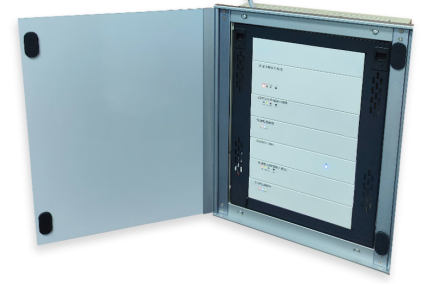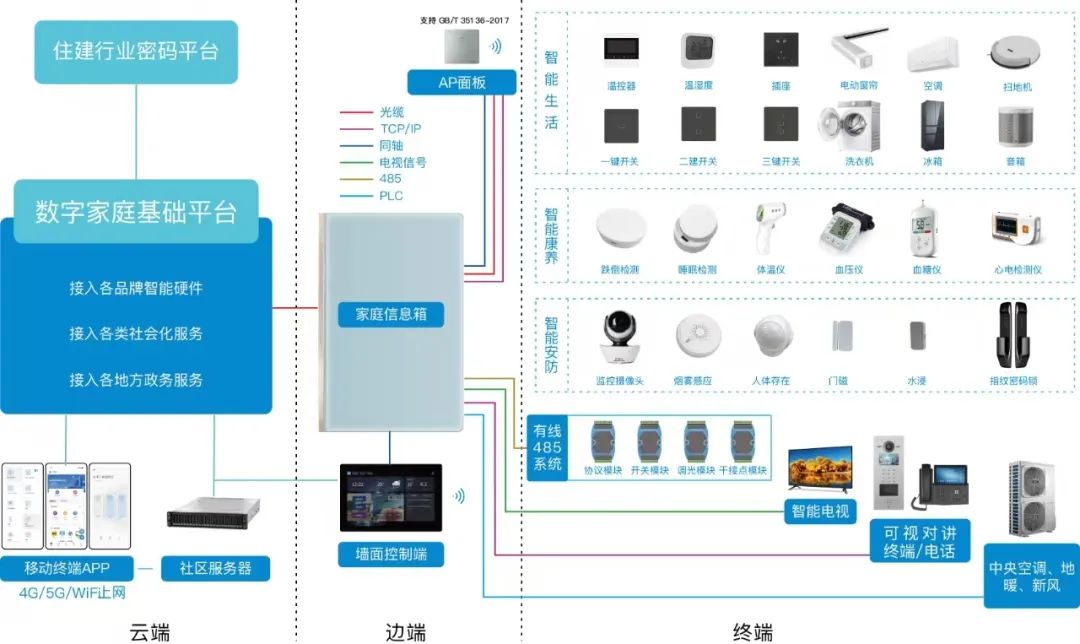The basic hardware of digital home includes three major devices: home information box, smart screen, and IoT access AP. Among these, the most core and important is the home information box, which serves as the control center, computing power center, data center, and network security center of the digital home system. It plays a key role in terminal device access, data aggregation and processing, and computing power support for the digital home system.
01
Modular Structure of Home Information Box
The information box adopts a modular structure, including comprehensive power module, home security module, optical broadband access module, home router AC module, cable television coaxial network access module, RS485 control module, etc. Each module is designed with standard dimensions for easy installation.

The information box should be equipped with a standard comprehensive power module, home security module, and optical broadband access module. The comprehensive power module provides independent DC power supply for each module and implements functions such as over-voltage, over-current, overload, short circuit protection, and lightning protection; the optical broadband access module completes optical fiber broadband network access, supporting GPON, EPON, IPON optical fiber input formats, and supports adaptive gigabit and hundred-megabit network ports.
The most core module in the information box is the home security module, which has data storage, data encryption, and computing power capabilities. It aggregates data from various dimensions and sources within the home, completing internal device management, scene management, and data security management, while providing computing power support for system operation, enabling various AI applications.
The modular design of the information box allows users to choose corresponding functional modules according to actual needs. For instance, in the renovation project of old communities, the “cable television coaxial network access module” can be optionally equipped. It comes with an RJ45 network interface that converts the home broadband network into coaxial network information, utilizing the existing cable television coaxial cables in old houses to transmit network signals to coaxial interface-type AP panels in each room, achieving full coverage of both broadband and narrowband networks in the home, effectively solving the problem of not being able to rewire in old renovation projects.
02
Functions and Roles of Home Information Box
In the two guiding policy documents, “Guiding Opinions on Accelerating the Development of Digital Homes and Improving Residential Quality” and “Notice on Carrying Out Pilot Work for Digital Home Construction”, the requirement of “promoting the application of comprehensive information boxes in residential units” is emphasized. This is because the information box, as the core hardware device of the digital home system infrastructure, has very important functions and roles, reflected in:
① Device Access and Interconnectivity
The information box is compatible with various IoT protocols and access methods, allowing access to various hardware devices from different manufacturers and ecosystems, achieving interconnectivity across enterprises, terminals, and ecosystems, providing users with a rich variety of enterprise and product choices, and facilitating centralized management of various devices and scene modes through the device management capabilities provided by the basic platform.
To ensure the quality of the wireless IoT network, at least one IoT access AP should be set up in each room of the home to achieve full coverage of the IoT network signal throughout the home. Wireless devices in each room connect to the information box through wall-mounted APs, ensuring good connectivity between terminal devices and the information box.

② Data Aggregation, Data Security, Data Learning
All dimensional data within the home space, such as environmental monitoring data, device operation data, user lifestyle data, sensor alarm data, etc., will be aggregated to the information box (home security module), breaking the data isolation state between devices, enterprises, systems, and departments, forming a complete integrated data set for home users, providing a data learning basis for AI models to comprehensively understand users, reason and judge, and provide proactive services.
Moreover, the information box (home security module) uses hardware encryption methods to ensure that the entire process of data storage, analysis, learning, and computing is completed within the information box, effectively safeguarding the information security, data security, and data privacy of families and users.
③ Computing Power Support for AI Applications
The extensive use of computing power to support AI models is a major feature of digital homes. The information box (home security module) can provide computing power resources, leveraging the family data and computing power resources stored internally to assist AI models in continuously learning various behavior patterns and lifestyle habits of family users, forming personalized digital housekeepers for each user, providing various AI services.

The home will upgrade from a physical space to a digital space, actively providing users with full-scene services covering various life dimensions based on data analysis and multimodal interaction, forming a full-chain digital life service model.
In summary, the basic platform, basic hardware, and industry password platform are indispensable and work closely together to form an organically integrated software and hardware infrastructure complex, meeting the construction requirements of “three major services, interconnectivity between system platforms and home products, information security, and data privacy” proposed in the “Guiding Opinions”. It also implements a system operation mechanism of “edge-centric and cloud-assisted”, where the entire process of data analysis and information processing is completed locally in the home, effectively ensuring the information security and data privacy of the family.
Once the infrastructure is laid out, the application ecosystem will grow freely on top of the infrastructure through market mechanisms, allowing the massive multidimensional information and data within future home spaces to fully integrate, and through close cooperation and unified scheduling between infrastructures, the life service processes can achieve full automation and intelligence, significantly improving service efficiency and quality.
For example, in the emergency response scenario of household gas leakage: when a sensor detects gas leakage, it sends an alarm signal to the information box; the information box combines multidimensional data, comprehensively judges and confirms the danger through the AI model, sends commands to close the gas valve, and turns on the fresh air system or other ventilation devices, and sends the alarm information to various parties such as the homeowner, property management personnel, gas company operation and maintenance personnel, and government emergency management departments through the basic platform.
Thus, it can be seen that the infrastructure, as the bridge and foundation connecting hardware devices and life services, organically integrates elements such as devices, platforms, data, information, and services. On one hand, it ensures the information security and data privacy of families; on the other hand, it fully leverages the collaborative value of data, computing power, and models, providing comprehensive empowerment for application hardware and services in terms of data security, data learning, computing power support, and model reasoning, bringing users a safe, reliable, and rich digital home life experience through AI analysis and proactive interaction. This is precisely why the basic platform, basic hardware, and industry password platform are collectively referred to as “digital home infrastructure”.